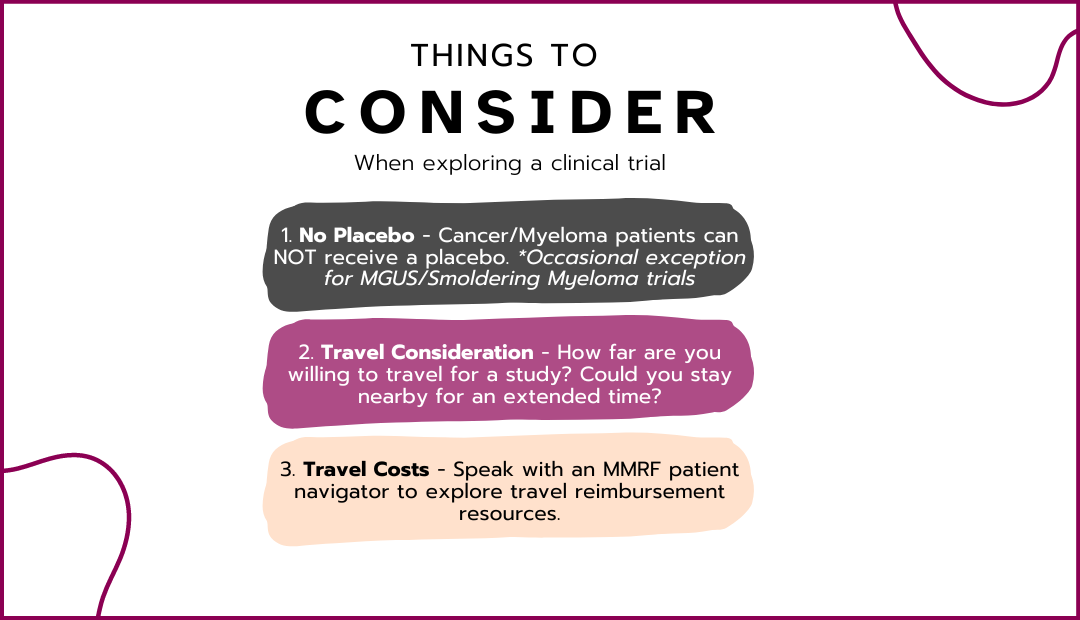Safety, Efficacy, and Pharmacokinetics of Continuous Subcutaneous Lenalidomide in Multiple Myeloma (MM)
NCT06087653
Age 18 +
Sex Both
Phase Phase 1, Phase 2
Third Opinion Trial Synopsis
In this clinical study, researchers are exploring a new treatment approach for patients with a specific type of blood cancer. The study focuses on a combination of therapies that aim to improve patient outcomes and potentially lead to better management of the disease. Here are some key points about the study:
- The treatment involves a combination of existing therapies and new agents that target the cancer cells more effectively.
- What makes this study unique is its focus on personalized medicine, where treatments are tailored to the individual characteristics of each patient's cancer.
- The study includes a diverse group of participants, which helps ensure that the findings are applicable to a wider population.
- Researchers are also looking at how well the treatment works in terms of reducing symptoms and improving quality of life for patients.
- Safety is a major focus, with ongoing monitoring to identify any side effects or complications that may arise from the treatment.
Third Opinion AI Generated Synopsis
Trial Summary
Primary Objective • Assess the safety and tolerability of low-dose lenalidomide administered by continuous subcutaneous (SC) infusion (STAR-LLD) in combination with dexamethasone and a proteasome inhibitor (PI). Secondary Objectives * To assess the immunologic activity of natural killer (NK) cells and T cells for innate and humoral immunity. * To establish the pharmacokinetic (PK) profile of STAR-LLD at a defined infusion rate targeting steady-state blood concentrations. * To determine pharmacodynamic (PD) changes with STAR-LLD in a panel of biomarkers associated with clinical response to lenalidomide. * Evaluate changes in efficacy indicators including objective response rate (ORR), progression-free survival (PFS), and duration of response (DOR). Exploratory Objective * To assess the impact of STAR-LLD on patient reported symptoms and outcomes. Primary Endpoints * The grade, frequency, and relationship of treatment-emergent adverse events (TEAEs) including adverse events of special interest (AESIs): (gastrointestinal \[GI\] toxicity, fatigue, hematologic toxicity, rash (non-infusion site). * The observation of dose-limiting toxicities (DLTs) of STAR-LLD during Cycle 1. Secondary Endpoints * Immune profiles, functional assays for NK cell activation and antigen specific T-cell activity. * Blood concentrations of lenalidomide at on Day 1 and at steady state. * Changes in biomarkers during treatment. * Rate of complete response, very good partial response (VGPR), partial response (PR), stable disease (SD), and progressive disease. * Determination of ORR, PFS, and DOR
Primary Objective • Assess the safety and tolerability of low-dose lenalidomide administered by continuous subcutaneous (SC) infusion (STAR-LLD) in combination with dexamethasone and a proteasome inhibitor (PI). Secondary Objectives * To assess the immunologic activity of natural killer (NK) cells and T cells for innate and humoral immunity. * To establish the pharmacokinetic (PK) profile of STAR-LLD at a defined infusion rate targeting steady-state blood concentrations. * To determine pharmacodynamic (PD) changes with STAR-LLD in a panel of biomarkers associated with clinical response to lenalidomide. * Evaluate changes in efficacy indicators including objective response rate (ORR), progression-free survival (PFS), and duration of response (DOR). Exploratory Objective * To assess the impact of STAR-LLD on patient reported symptoms and outcomes. Primary Endpoints * The grade, frequency, and relationship of treatment-emergent adverse events (TEAEs) including adverse events of special interest (AESIs): (gastrointestinal \[GI\] toxicity, fatigue, hematologic toxicity, rash (non-infusion site). * The observation of dose-limiting toxicities (DLTs) of STAR-LLD during Cycle 1. Secondary Endpoints * Immune profiles, functional assays for NK cell activation and antigen specific T-cell activity. * Blood concentrations of lenalidomide at on Day 1 and at steady state. * Changes in biomarkers during treatment. * Rate of complete response, very good partial response (VGPR), partial response (PR), stable disease (SD), and progressive disease. * Determination of ORR, PFS, and DOR
from ClinicalTrials.gov
Locations & Contact
Fill out the form and to let the Multiple Myeloma Research Foundation know you are interested in this trial.
Contacts:

